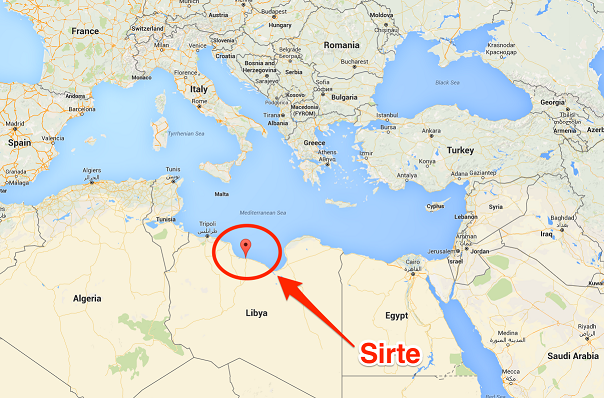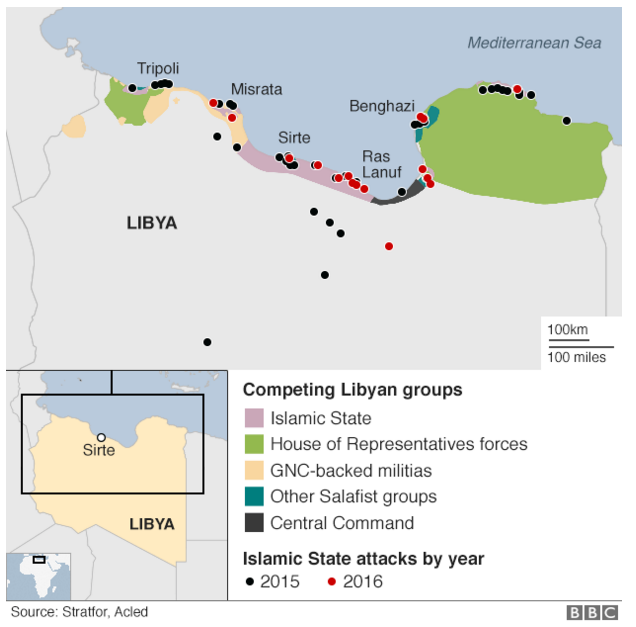You have to hand it to ISIS – they move fast & they move with purpose. It seems just like yesterday when we began talking about where ISIS was planning to move to escape from Russian bombing in Syria. On December 12, 2015, we described how ISIS was making Gaddafi’s old hangout of Sirte their new base. Sirte was such an obvious choice – on the Mediterranean with easy access to Europe, in the middle of the rich oil region of Libya and away from Russia’s bombings.

Guess what? In less than two months, the ISIS in Libya story has moved from relative obscurity to front page news. Now ISIS controls over 150 miles of Libya’s coastline
- Eurasia Group @EurasiaGroup – ISIS: now on the ground in Libya

This week CNN showed a video clip of ISIS in Libya that looked just like the 2014 march of ISIS into Iraq. The New York Times wrote an article describing President Obama’s unwillingness to attack ISIS in Libya despite the case being “laid out by virtually every department“. Instead, as NYT reports, the President has asked his staff to “redouble their efforts to help form a unity government in Libya“. In other words, a repeat of the Syrian strategy which resulted in various factions fighting with each other and ISIS becoming the dominant force.
Now that the ISIS presence in Libya has become visible and on the radar of mainstream media, it is time to look where ISIS is going next. Attacking ISIS is not like a NFL defense swarming to an immobile quarterback; playing ISIS is a game of ice hockey where, as the Great One taught decades ago, you have to skate where the puck is going.
1.Peer-to-Peer vs. Wheel-n-Spoke
To put it another way, ISIS is employing a peer-to-peer networked strategy of opening geographically dispersed conflicts & bases in its campaign to build a caliphate. ISIS excels at building units that have remarkable agility & freedom of decision making to fight their own conflicts in their areas. This is how ISIS spread so fast in Iraq. That is how they expanded to Libya & will expand next to North Africa.
Like most NFL defenses with a powerful defensive line & linebackers, the USA is best suited to concentrate its attack on a central HQ like taking out Saddam Hussein’s Iraqi army in a week. When the enemy is arrayed in a Wheel-n-Spoke formation – with one central HQ & spokes radiating from the center – America can take out the center and collapse the entire formation.
But American military-political structure is not suited to fight a peer-to-peer enemy structure. The US state department is organized into geographic silos with specific desks for each region/country. Consider how many people or units you would have to go through if a US military unit in Iraq wanted to attack an ISIS contingent inside Libya.
ISIS, in contrast, is built for mobility and agility, the classic Arab fighting strategy that was used by Salah-ud-din to defeat heavily armed Crusaders of Lion Heart Richard. It is the same strategy Lawrence of Arabia used to attack heavily armed Turkish forces in Syria. And ISIS is taking this to a whole different level.
The success of the Bush-Petraeus “surge” in Iraq forced the bad guys to move laterally to Syria where they formed the group that is now called ISIS. The founding strategy of ISIS has been to go where the US is not, to take territory & control the civilians to get revenue for themselves & protection from American Airforce that will not bomb targets full of civilians.
The best way for America to defeat ISIS strategy is to attack them in the new area they are moving to before they take territory with civilians. Given America’s dominance of aerial intelligence and the open terrain of the Middle East, this should have been easy for the Obama Administration to do. David Kirkpatrick of NYT first wrote about ISIS opening a front in Sirte, Libya in March 2015. The Wall Street Journal described the success of that effort in November 2015. Wouldn’t those have been terrific opportunities to destroy the ISIS expansion in Libya? Bomb them before they have a chance to take territory & rule over civilians? But that is not how the Obama Administration works and, frankly, that is not what the ponderous US military-political establishment is built to do.
So where is ISIS going now?
2. Back To Where It All Began
Where did it all begin? Afghanistan, of course. That is where Osama Bin Laden went when Saudi Arabia became too hot for him. After 9/11 and after the overthrow of the Taleban government in Afghanistan, his Al Qaida moved back to the Middle East. And now Syria is becoming too hot for ISIS and even Libya may become hot when US-Europe finally get their act together. So where can ISIS build their third base? You guessed it, Afghanistan. That theater where the Obama Administration is ready to call a victory and move out. Isn’t that a perfect time & place for ISIS?
But Afghanistan is different from Libya in one big way. Afghanistan is close to where a hockey player rules, a player who knows the Gretzky dictum. That is why, as Foreign Affairs wrote this week, Vladimir Putin is now talking to the Taleban to stop ISIS before they can get established in Afghanistan.
Imagine how stunning this is. The Taleban was formed from the ranks of the mujahedeen or fighters who waged a brutal 10-year war against the Soviet occupation of Afghanistan from 1979 to 1989. Over a million Afghans died in that war against USSR. Putin’s Russia has been opposed to the Taleban since their birth as a movement in the 1990s. So why are these two sworn enemies trying to make amends as Foreign Affairs put it?
According to Foreign affairs, Zamir Kabulov, Russia’s special envoy to Afghanistan, recently said, “Taliban interests objectively coincide with ours”. The article added “Kabulov …. rationalized the new cooperation” by adding that “the Afghan and Pakistani Taliban have said they don’t recognize [Abu Bakr] al-Baghdadi as the caliph; that is very important.” The article also quotes one Taliban leader saying, “If we could talk to the West, what’s wrong talking to Russians and Afghanistan’s neighbors in north?” And the “Taliban sees Russia’s cooperation as a route to political legitimacy and an upper hand over ISIS“.
The Taleban cannot compete with ISIS financially. ISIS is reportedly paying its recruits in Afghanistan about 3-5 times what the Taleban pays its fighters. And Russia is not opposed to the Taleban’s overriding goal of reconquering their country. This, according to the article, is no longer limited to verbal parlays:
- “Russia has supplied the Taliban with large caches of arms, … At the same time, the Taliban has formed and deployed a 1,000-member special forces detachment, arguably equipped with Russian-supplied intelligence, to fight ISIS.”
The Taleban may be an old enemy for Russia but the Taleban have been a purely Afghani operation devoted only to reconquering Afghanistan. ISIS has more global aims that include spreading its caliphate to Central Asian countries in the Russian sphere. That is why stopping ISIS from entering Afghanistan is a strategic priority for Russia.
- “Russian intelligence estimates show that about 2,400 people from the Caucasus have joined ISIS. (Other estimates indicate that between 5,000 and 7,000 volunteers from Russia and Central Asia had joined the group.) If those fighters chose to flee the Russian bombing campaign for greener pastures, they will likely head East to return home. And that path could go through Afghanistan“
Russia is helping both sides in the fight between the Taleban & the Afghan Government:
- “One the one hand, it feeds critical intelligence and perhaps weapons to the Taliban, a group long designated by Moscow a terrorist organization, but, on the other hand, it continues to provide weapons and military hardware to the Afghan government to fend off extremist groups like ISIS and the Taliban”.
Afghanistan is not Syria. Intense bombing from the air will not suffice in Afghanistan as Russia remembers very well. And Putin is not going to risk putting Russian ground troops back into Afghanistan and provoke another Jihad. Working with whoever ends up running Afghanistan is a more effective & lower cost strategy for Russia.
That is not all that different from America’s approach to Afghanistan. After an expensive & fruitless 14-year war, everyone in America is tired of Afghanistan. But America cannot pull out of Afghanistan without ensuring at least a semblance of a stable & non-terrorist government in Kabul. This is why the Obama Administration has been trying to persuade the Taleban to join a “unity government” in Afghanistan. The Taleban are not interested because they are winning and hope to overthrow the US-backed government in Kabul. In short, the Obama Administration is walking fast but going nowhere.
Russia is also stymied in what it can do in Afghanistan. They are not on the ground there and don’t want to be. To cover most of the bases, Russia is building a relationship with the NonPakistan military. Russia has announced joint exercises with the NonPak army and there is talk of selling arms to NonPak. All this may not be enough. The one base that Russia would like to cover is “the United States’ elaborate web of human and technical intelligence and surveillance“.
If there is one place where both America & Russia can work together is Afghanistan. Ensuring a stable Afghanistan & keeping ISIS out are common objectives of every one – foreign powers like America, Russia & China as well as neighbors Iran & NonPakistan. The real question is can the Obama Administration overcome its deep anger against Putin and begin to build a working relationship with Russia in Afghanistan? Geostrategy like politics is finally about personal relationships and the one between Obama & Putin is as toxic as any.
Send your feedback to editor@macroviewpoints.com Or @MacroViewpoints on Twitter
India seems to completely out of the picture, its scary. After all, it “coming soon … to a theater near you ” …. but I guess India still wants to send “strongly worded demarches” for every Pathankot … clearly not the action of a Power , forget great or middling ….
Unfortunately India is “completely out of the picture” because India is irrelevant to Afghanistan; Indian became irrelevant to Afghanistan when India gave up part of Kashmir that sits between India & Afghanistan; Now India has no border with Afghanistan & NonPakistan is in between. That was the stupidest act of Independent India & now India is paying for it.